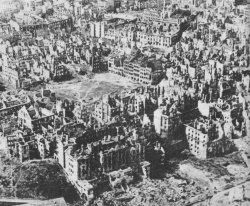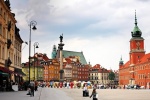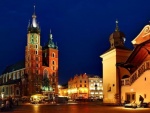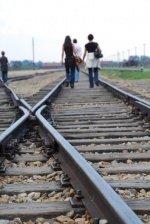World Tour: Poland
Author: Asandra al'Terra

World Tour: Poland
The second stop in our World Tour series is Poland. It’s a wonderful country that has many different sides. Here, I (Asandra) will be highlighting three different cities: Warsaw, Cracow, and the Tri-City area (okay, that’s five, in theory. Quiet, you).
Warsaw (Warszawa in Polish; pronounced Var-shah-vah) is the capital of Poland. By the end of the Second World War, over 80% of buildings were destroyed by bombings – the black-and-white picture depicts the ruins of the Old Town Market Square.
Luckily, the city has been rebuilt, and walking around the Old Town is a genuine pleasure. There are open-air restaurants everywhere, where you can eat pierogi (dumplings, stuffed with everything from meat to strawberries), placki ziemniaczane (potato pancakes), and kiełbasa (sausage) to your heart’s content. During the summer, street vendors also sell freshly made cotton candy.
Be sure to visit A. Blikle, arguably the most famous bakery in Poland, for some pączki (donuts stuffed with rosehip jam, topped with icing and candied orange rind). Also take a look at Łazienki Park, which occupies 76 hectares of the city center and is the location of the annual, outdoor Chopin concerts (pictured).
Warsaw is almost dead center of the country. If you head to the southern tip, you’ll end up in Cracow (Kraków in Polish; pronounced Crack-oof). Cracow used to be the capital of Poland, and even now, it’s extremely important to the history of our country.
My theory is that one’s first stop in every European city should be the Old Town, and it’s no different here. Here, you’ll find the Kościół Mariacki (St. Mary’s Church). It’s a beautiful church, and has a musical bonus: every hour, a trumpet signal (the Hejnał Mariacki) is played from one of the spires in remembrance of the 13th century Mongol attack on the city. The tune breaks off partway through, commemorating the messenger who sounded the alarm of the attack, and was shot in the throat before completing the piece.
Also in the Old Town: numerous restaurants and cafés, as well as the Sukiennice (Cloth Hall) smack-dab in the middle, which was a major center of international trade in the 15th century. You can still buy traditional Polish gifts there – especially amber, which is a beautiful souvenir!
The Jewish Quarter is also close to the Old Town. There are amazing restaurants there, and annual summer concerts at the end of the summer. The crowds are huge, but worth it.
Another great place in Cracow is the Wawel castle, complete with a dragon (no, really). Legend has it that this dragon was terrorizing the country, and the King wanted him dead (of course). Many had tried to face this dragon, but none had succeeded. People were afraid to leave their homes, and the dragon roamed the countryside feely, eating sheep and cattle and people, too.
A young man named Krak came to the area, and asked the King if he could slay the dragon. He had no sword, no armour, and barely a penny to his name, but the King would take whatever help he could get.
Krak bought a sheep from the butcher and some sulfur from a minor, and hatched his plan: in the dead of night, Krak killed the sheep and took out its insides, replacing them with sulfur. He then surreptitiously left the stuffed sheepskin outside the dragon’s lair.
Come morning, the dragon came out of its cave and ate the sheepskin. The sulfur ignited and started burning the dragon, who – in a panic—ran to the nearby Vistula river and tried to drink the pain away. He drank so much that he filled up like a balloon. Krak began to throw stones at the dragon who – upon his attempt to breathe fire – exploded instead.
And that is how a young shoemaker’s apprentice saved the day. A dragon bone remains on the door of Wawel castle, which was built upon the dragon’s lair, to this day.
While visiting Cracow, you can go outside the city for two things: one of beauty, one of tragedy. The Tatra mountains are a short ride from town, and you can hike the trails for ages. They’re utterly stunning – and rather than just picking one picture to show you, I’ll let you guys see the range of beauty available there.
More importantly, Auschwitz is also a short drive outside the city. I won’t go into the history here, but leave you with this picture from my visit, and the exhortation to go. It’s important.
Finally, we snake our way to the northern tip of Poland, to the Tri-City area: Gdańsk (my dad’s hometown), Gdynia (my mom’s), and Sopot. They’re all very close together, and on the Baltic sea.
While there, you can walk on the sea and have fish and chips by the water. If it’s cooler out, I also strongly recommend mulled wine (grzaniec) or mead (miód pitny) – both delicious, and perfect for getting the chill out of one’s bones.
If you come during the end of July or beginning of August, you’ll also encounter the Jarmark Dominikański, a street festival where you can buy… well, almost anything. There are shows for kids and adults alike, concerts, and almost anything else you can think of.
Poland has so much to offer, and such a deep history. If you’ve been – what else would you recommend to see? If you haven’t – do you have any questions about these places, or others you want to see?
Thank you for travelling with the Tar Valon Times!






